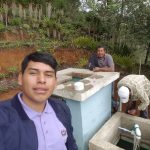Everything but the Kitchen Sink.
With a baby on one hip and two more little ones underfoot, by any measure, Tuburus resident and mother, Marik, has her hands full. She also has her water buckets full, her rice husker full, and a full pot of something on the stove. All signs of a full day, no doubt. But also a typical day to be sure.The water in the buckets lined up on a ledge in her modest kitchen comes from both the Coco River – water Marik hauls up the bank for doing the washing – and water from a stream where she collects the family’s water for drinking and cooking.There is no water system here. No tap.No kitchen sink.

While far cleaner than the Coco River, the 24-hr bacteria test conducted on the Tuburus stream water does not take nearly that long to turn from orange to black, revealing high levels of bacteria, and confirming the very water being consumed as a contributor to recurring health issues in both adults and children. During the few months of the year when the stream dries up, Marik describes the process of digging a small hole on the shore of the Coco River. She lets the water seep slowly in from below, relying on the sand to act as a filter as the hole is filled and water is collected from it — a clever, perhaps, albeit not entirely effective, precaution against river contaminants when the stream runs dry.
Our Within Reach campaign aims to make safe water more accessible to families by tapping into local water sources, improving safe water systems, strengthening water boards – bridging the gap so that remote communities can receive the benefits of consistent access to safe water that we all enjoy from our own kitchen sinks. With your help.






